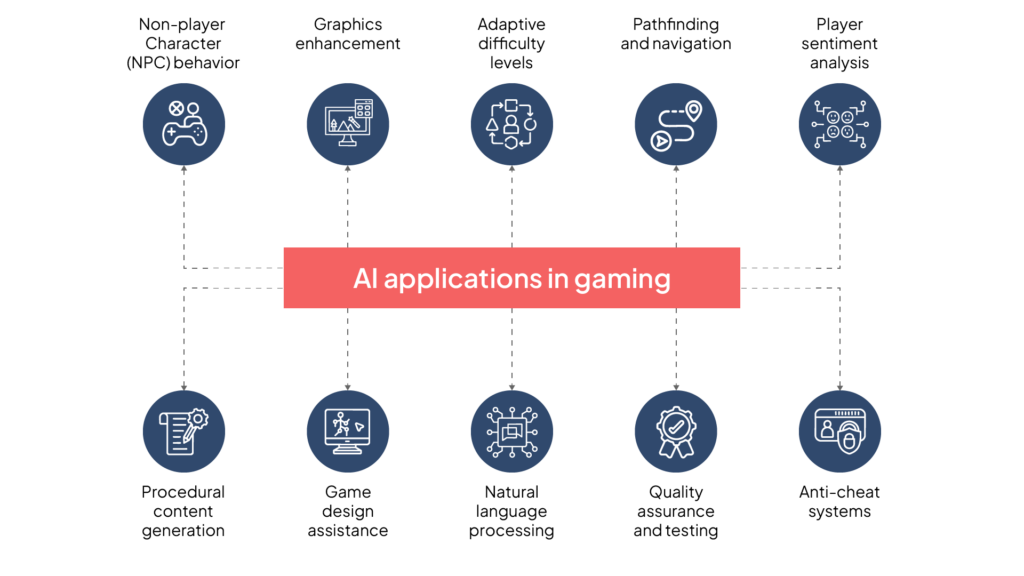Don’t we all love games involving multiple players? Yes, we do. Remember those nostalgic times playing Monopoly with friends or family—the thrill of fake currency and feeling “rich”! Now, thanks to online versions, classics like Monopoly and Call of Duty are more accessible than ever, bringing all the fun straight to our mobile phones with engaging gameplay, minimal lag, cross-platform access, and personalized recommendations. So, how is this possible? It’s all thanks to serious technology adoption by gaming companies.
The emergence of mobile gaming has made cloud computing essential for delivering seamless, cross-platform experiences. Combined with data analytics and AI, these technologies personalize gameplay, analyze player preferences, and provide real-time insights, keeping users immersed and engaged. Together, they ensure minimal downtime and set new standards in the gaming industry, giving players an uninterrupted, personalized adventure across devices.
Technological innovations are seismically changing the online gaming industry. Immersive technologies like virtual and augmented reality are elevating the user’s experience by integrating the real and online worlds.
In this blog, let’s explore:
- Why is the gaming industry moving to cloud gaming?
- The current pain points in the online gaming industry
- Best tech-driven strategies to scale business growth in online gaming
Let’s start this blog with some of the latest industry trends.
Why is the gaming industry moving to cloud-powered gaming?
AI technology is reshaping how gaming characters are designed and presented. There is a massive thrust towards developing more “intelligent” and “adaptive” games in 2024.
Similarly, Generative AI is making gaming characters “feel and think” like real humans. For instance, these characters can remember previous interactions with gaming enthusiasts and personalize their actions accordingly.

Among the emerging trends, cloud gaming is eliminating the hardware-related barriers for many users. No longer do online gamers need a high-end gaming console or a high-resolution computer.
According to EY, “82% of gamers would skip purchasing new gaming hardware in favor of the cloud if connectivity guarantees performance.” It’s no surprise that cloud gaming is expected to reach a value of $96.67 billion by 2034 – up from just $2.27 billion in 2024.
A leading Los Angeles-based gaming company is surging ahead with a revenue of $107.3 billion in 2023. With free mobile games like Monopoly Go! and Scrabble Go, the company’s 500 million users have spent nearly 5 billion hours on these games.
Compared to traditional gaming, cloud-powered gaming offers a host of advantages, including:
- Cost-effectiveness in the longer run
- Scalability or the ability to add more players without any performance drop
- Compatibility with multiple devices including mobile phones, desktop computers, and tablets
The rollout of 5G networks has also been a “game-changer” for cloud-powered gaming. This is also driving the problem of massive data overload in the gaming industry. Next, let’s discuss some of the key challenges facing this industry – and how they can be overcome.
Challenge#1 – Data overload
As of 2024, there are over 3 billion online gamers across the world. 6 in 10 players played multiplayer games frequently during the pandemic.

Typically, a successful gaming company like Scopely generates around 50 terabytes of gaming data each day. This massive data overload can create infrastructure-related challenges for gaming companies and impact the player’s experience.
That said, the massive data volumes also present gaming companies the opportunity to extract valuable insights such as:
- Understanding the player profiles.
- How players are interacting with the game.
- How likely they are to engage – or get bored – with the game.
With the use of AI-powered gaming analytics, companies can now turn around the massive gaming data for their advantage through real-time actionable insights on the real-time data.
Challenge#2 – User engagement
User engagement is a key element to incentivize the player to continue playing online games and become a master player. As gaming companies keep improving the player’s experience, user engagement is challenging particularly with legacy games.
A recent example is that of Redfall from Arkane Studios, which failed to live up to players’ expectations.This online game is being criticized for its outdated graphics, core gameplay, and lack of matchmaking.
Besides, legacy tech in games struggle to manage a large number of simultaneous players, which quickly leads to poor performance and high churn rates. In today’s competitive gaming market, players need a personalized gaming experience to keep them “hooked” to the game.
With AI-powered gaming analytics, companies can gauge customer behaviors based on metrics such as:
- Number of likes and dislikes
- Average number of gaming sessions
- Churn rate
Challenge#3 – Monetization issues
With a host of free games available, online players do not want to pay upfront for any game. Paid games also have a shorter lifespan. 83% of mobile games fail within the first 3 years. To monetize their online games, companies opt for measures such as in-app purchases or online advertising.
However, poor advertising strategies and limited in-app purchase options can cause more monetization issues. For instance, aggressive advertising or irrelevant ads that do not suit the game can frustrate most players.
With the use of AI technology in online gaming, companies can improve their monetization strategies in the following ways:
- By using AI-powered analytics to customize game monetization models – based on the player segment.
- Using AI algorithms to analyze each player’s behavior to understand their playing habits and preferences.
- Offering a dynamic pricing model where in-gaming items are priced based on demand and the player’s spending habits.
- Optimizing ad placement in the game to minimize disruption and player frustration.
Challenge#4 – Lack of gaming features
Player engagement is also impacted by legacy (or traditional) games with limited interactions and features. Game development is a costly process, thus leading companies to cut down on the “risks” of developing new gaming features and enhancements. This lack of innovation ultimately impacts the game quality and player experience.
Along with AI technology, cloud technologies allow gaming companies to build feature-rich games without investing in expensive hardware. Besides enabling high-quality graphics and processing power, cloud-powered gaming is “hyper-personalizing” the online gaming experience.
Similarly, the use of AI in gaming can improve the gaming experience through its algorithms. By analyzing real-time gaming data, AI algorithms can identify performance bottlenecks and inefficiencies.
Challenge#5 – Lack of real-time streaming functionalities
Real-time video recording and streaming in online games face a host of technical challenges including:
- Limited internet bandwidth
- Incompatible devices
- Playback problems
- Load balancing
- Limited scalability and availability
Powered by cloud platforms like Google Cloud and AWS, gaming platforms can optimize the delivery of high-quality video and streaming content. For instance, Google Cloud’s content delivery networks can deliver streaming media content with low latency. Similarly, with Amazon CloudFront, the AWS platform can deliver live streaming content with low latency.
How can gaming companies overcome these challenges? Let’s discuss how technologies like AI and multi-cloud platforms can help them scale their business performance and growth.
Best practices and strategies for business growth and performance
Here are 6 best practices and strategies for online gaming companies to accelerate their business growth:
- Deploy a scalable cloud infrastructure
During peak usage, popular gaming applications can suffer from high data latency and below-par performance. With a scalable infrastructure, gaming companies can address this problem.
With their auto-scaling capabilities, cloud services like AWS Elastic Beanstalk and Google Kubernetes Engine (GKE) can automatically scale the underlying cloud infrastructure based on real-time demands.
Besides that, a scalable game design can also overcome performance bottlenecks. Here’s how to design a scalable game for optimum performance:
- Define the scope of the game including the gameplay, target audience, number of concurrent players, and their expected game interactions.
- Optimize the gaming assets including graphics, sound, scripts, and animation.
- Balance the multiplayer game design based on its difficulty levels, player rewards, and skill level.
- Optimize the network infrastructure
As more players join the game from multiple regions or locations, it’s important to reduce the data latency with network accelerators and globally distributed servers. For instance, by deploying the AWS Global Accelerator, companies can optimize traffic routing between the gaming server and the client.
Similarly, Google Cloud CDN can reduce data latency by:
- Caching real-time content in Google’s servers.
- Reducing the load on Google’s backend servers.
- Supporting networking protocols like HTTP/2 and QUIC.
- Using TCP and HTTP optimization from HTTP/2 for application load balancing.
- Implement a multi-cloud strategy
For multiplayer games (like Monopoly Go!), companies cannot rely on a single cloud platform. Instead, an integrated multi-cloud environment – comprising Google Cloud, AWS, MS Azure – can easily support a larger pool of players.
Here are some benefits of a multi-cloud strategy for gaming companies:
- Leverage the capabilities of each of the cloud platforms depending on the game requirements; for instance, Google Cloud for advanced analytics and AWS for heavy workloads.
- A multi-cloud environment provides the optimum flexibility and scalability required to scale gaming apps based on their current demands.
- Eliminate the pitfalls of vendor lock-in, as multiple cloud players are now involved in the company’s cloud strategy.
- Develop an efficient low-latency cloud infrastructure to improve response time and performance.
For example, Google Cloud enables live gaming with its expertise in Google Kubernetes Engine (GKE), which is capable of running over 15,000 node clusters.
- Leverage AI and machine learning for insights
With over 2 billion players across the globe, it’s obvious that gaming companies generate massive amounts of gaming data. Companies that can use big data to understand their customers have a distinct advantage over their competitors.
Here’s how AI and machine learning are transforming the gaming industry:
- Personalizing the gaming experience – AI-powered algorithms can understand each player’s behavior and preferences, thus enabling them to deliver a personalized experience. By analyzing the player’s gaming skills, an AI-powered system can suggest personalized tips to improve their skills.
- Creating “human-like” gaming characters – AI technology can make the gaming experience more “realistic” by creating characters with human-like behavior. Further, AI-enabled characters can bond with players and form dynamic relationships for improved player engagement.
- Enhancing monetization opportunities – With AI-powered analytics, gaming companies can improve their monetization opportunities. For example, AI-powered personalized ads can cater to the player’s real-time behavior, thus improving the monetization outcome.
- Enhance the gaming experience with AR/VR
Immersive technologies like augmented reality (AR) and virtual reality (VR) have had a profound impact on the online gaming experience. With its high-resolution graphics in real-world environments, AR provides a realistic experience for gaming enthusiasts. Some popular AR-powered games include ARSports, Pokemon Go, and Ingress Prime.
On the other hand, VR in gaming is delivering a completely “virtual” experience using headsets, haptic devices, and wearable technology. However, AR/VR systems in gaming are difficult to scale due to cost factors like advanced hardware and data storage requirements.
Cloud platforms are playing a crucial role in meeting scaling requirements in AR/VR systems. Besides that, Google Cloud is also delivering better performance with 3D holographic images, 100x faster data processing, and video rendering capabilities. - Execute data modernization
Like any other industry, data is critical to the success of any gaming company. Real-time gaming data is powering areas like:
- New game development
- Monetization strategies
- Personalizing the player’s experience
However, outdated and siloed legacy systems are no longer suitable for extracting real-time data analytics for faster decision-making. Through data modernization, gaming companies are migrating their data from legacy systems to cloud-powered platforms. Additionally, gaming companies are training their AI models using synthetic data to produce better outcomes.
Cross-platform gaming is also gaining more popularity among game enthusiasts. Besides the high game development costs, cross-platform developers have to ensure consistent performance across multiple devices and platforms. Without a cloud-powered modernized system, gaming companies can find this challenging to implement.
Onix’s Cloud and AI Solutions for Gaming Companies
Onix brings years of experience in delivering customized solutions for various industry domains, including the online gaming industry. With a clientele of over 1,500 across the globe, we deliver the following technology expertise & services – all under a single roof:
Our tailored industry solutions are designed to address the pain points of gaming companies and accelerate their business growth. Want to know more about improving player engagement and gaming experience? Contact us today.









